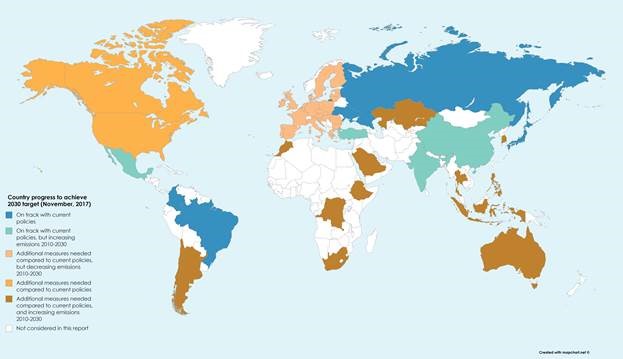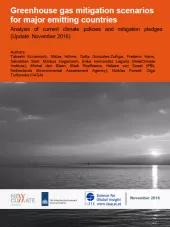This new report by NewClimate Institute, PBL Netherlands Environmental Assessment Agency and the International Institute for Applied Systems Analysis (IIASA) provides an overview of projected greenhouse gas emissions in 25 major emitting countries/regions up to 2030, taking into account the emission trajectories based on current policies and the implementation of intended nationally determined contributions (INDCs) and nationally determined contributions (NDCs).
The study concludes that 16 out of the 25 countries and regions analysed are not on track to achieve the NDC targets they have set for themselves. This study updates our 2016 report.
About two thirds of the 25 major emitting countries not on track to achieve targets set in NDCs
The degree to which the 25 major emitting countries are likely to achieve their NDC targets under current policies was found to vary (see Figure).
- Of those considered in this report, Brazil, China, Colombia (new), India, Japan (new), Mexico (new), the Russian Federation, Turkey, and the Ukraine are likely or roughly on track to achieve or even overachieve their self-determined unconditional 2025/2030 targets with currently implemented policies.
- Countries that require additional measures to achieve their 2025/2030 targets are: Argentina, Australia, Canada, Chile (new), Democratic Republic of the Congo (DRC), Ethiopia, the EU, Indonesia, Kazakhstan, Morocco, Republic of Korea, Saudi Arabia, South Africa, Thailand, the Philippines and the United States.
- Colombia is now assessed as achieving its INDC, because recent emissions, in particular from forestry, were lower than assumed in the business-as-usual (BAU) projections.
- Mexico is now assessed as achieving its NDC with currently implemented measures, mainly because of the historical emission data update and updated and lower baseline projections.
- Chile is now assessed as requiring additional measures to achieve its 2030 targets, mainly because of the change in the baseline projections used for the assessment.
Currently implemented policies are projected to influence greenhouse gas emissions, but do not prevent emissions from increasing up to 2030 (above 2010 levels). This is the case, not only in developing countries (Argentina, China, DRC, Ethiopia, India, Indonesia, Kazakhstan, Morocco, the Philippines, Saudi Arabia, South Africa, and Thailand) but also in OECD countries (Australia, Chile, Mexico, Republic of Korea, and Turkey) up to 2030, compared to 2010 levels. Greenhouse gas emissions in Brazil, Canada, Colombia, the Russian Federation, and the Ukraine are projected to remain stable, approximately at current levels, with currently implemented policies. In Japan and the EU, greenhouse gas emissions are projected to decrease further, under current policies.
It should be noted that a country likely to meet its NDC/INDC not necessarily is undertaking more stringent action on mitigation than a country that is not on track, as this depends on the ambition level for the nationally determined target, and because countries have different policy-making approaches.
Nevertheless, as countries are adopting implementation measures, it is essential that the gaps between mitigation targets and current policy trajectories begin to close, in the years to come. Most of the countries analysed in this report show progress towards meeting their NDC; some through additional policies and new market developments, some through revision of the underlying data. A few countries risk reversal of the trends. For this reason, it is essential that this report and similar efforts are updated in the coming years. We also believe that this study provides useful information for the 2018 facilitative dialogue.

Methodology changes compare to 2016:
- Policy developments since the last report (e.g. the changes in U.S. climate policy) have been taken into account in the emissions projections (cut-off date: 1 July 2017).
- GHG emissions projections under current policies took into account reviews from in-country experts involved in the European CD-LINKS project (CD-LINKS 2017) to identify policies, not limited to those focused on energy and climate, expected to deliver significant impact.
- Historical GHG emissions data was taken from latest inventories, many of which have been submitted to the UNFCCC in 2017.
- GHG emissions projections under current policies were harmonised to the latest historical emissions data described above. The harmonisation year was changed to 2015 for Annex I countries and 2010 for non-Annex I countries, with exceptions of China (2012) and Brazil (2015) (previously 2010 for all 25 countries).
- 2020 pledges and NDCs were consistently quantified in terms of 100-year global warming potentials (GWP) from the Second Assessment Report (SAR) of the Intergovernmental Panel on Climate Change (IPCC).




